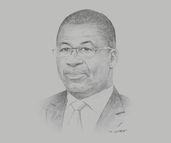Hien Yacouba Sié, General Manager, Autonomous Port of Abidjan (Port Autonome d’Abidjan, PAA): Interview

Interview: Hien Yacouba Sié
What is being done to maintain the country’s status as a West African maritime hub?
HIEN YACOUBA SIÉ: Côte d’Ivoire is one of the three-largest economies in West Africa and is the driving force of UEMOA, accounting for roughly 40% of its GDP. The country’s economic dynamism translates into an 8% growth rate, one of the highest such rates in the world. The PAA benefits from its strategic position at the crossroads of shipping lines from the north and south, guaranteeing a balance in import and export traffic.
Côte d’Ivoire has upgraded its infrastructure in order to remain a hub in the West African subregion. This involved carrying out improvements to existing facilities as well as the development of new infrastructure that is better adapted to current needs and expectations. For example, the Vridi canal was enlarged and deepened to enable it to receive a new generation of larger boats. More recently, in March 2018 the first berth of the new roll-on/roll-off terminal was put into service. Lastly, a backfilling project created 40 ha of additional land to deal with the port’s congestion and lack of space for storage and new factories. All these initiatives aim to put the port ahead of its regional counterparts.
How is the construction of a second container terminal economically strategic?
SIÉ: The country’s recent increase in global trade reflects its economic revival. Some 76% of the traffic flow these exchanges induce travels through the PAA, and given the country’s predicted economic outlook, these volumes should continue to grow. The low draft of the container terminal and its saturation, observed since 2010, called for the construction of a second container terminal. The second terminal is a determining pillar of the vast infrastructure modernisation programme launched to support Côte d’Ivoire’s economic development. It will provide an appropriate response to the continued growth of trade between our country and the rest of the world and reinforce its position as a hub for subregional external trade by accommodating last-generation container ships. Both in the construction and operating phases, the second terminal is also a source of direct and indirect jobs.
What projects are under way to improve the efficiency of port entry and exit procedures?
SIÉ: The PAA uses a modern business information system, which includes virtualisation, data interoperability and mobility concepts. This platform covers the port’s main fields of activity such as ship stopover, freight billing and state management. Additional projects set to be implemented include dematerialisation of goods data, and centralised stopover management through the one stop shop foreign trade window. Lastly, as part of the Project to Support the Competitiveness of Greater Abidjan, we are looking forward to implementing a digital truck movement platform. This tool should increase the efficiency of goods movement within the port area, allowing for greater traffic and visibility.
How will the modernisation of the railway line from Abidjan affect port traffic?
SIÉ: Rail and roads are essential infrastructure, and multi-modalism – the interconnection of maritime, road and rail links – is unanimously considered a leverage of economic development. In line with this idea, the 5400 km of paved roads serving the hinterland and neighbouring countries, and the 1250 km railway line between Abidjan and Kaya in Burkina Faso are being updated. The programme plans to restore 853 km of railway line and 31 stations between 2018 and 2021. These works should allow the transportation of 5m tonnes annually, including 2m tonnes of general cargo and 3m tonnes of ore. They will also reinforce Côte d’Ivoire’s economic ties with Burkina Faso, a country with widely recognised potential in the mining sector. The greater fluidity in the transport of goods should boost our transit traffic with neighbouring countries.
You have reached the limit of premium articles you can view for free.
Choose from the options below to purchase print or digital editions of our Reports. You can also purchase a website subscription giving you unlimited access to all of our Reports online for 12 months.
If you have already purchased this Report or have a website subscription, please login to continue.

